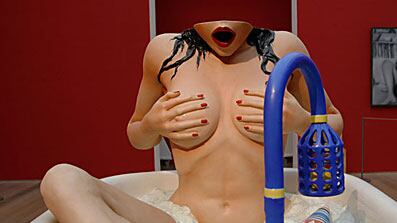The feeling that the art world had become disquietingly like the commodities market was very much in the air in the mid ‘80s when Jeff Koons first appeared on the scene. The young artist, who was more than ready to discuss his short career as a trader in a Wall Street boiler room, played into this and many critics, including some usually percipient ones, were ready to dismiss him as manipulative and cynical.
Well, the years have passed and it has become ever more plain that Koons was never really into bizspeak, that his language, at once button-pushing and ingenuous, has always rather resembled that of a motivational speaker and that what he says, which can zig and zag from the abstract to the nuts-and-boltsy, casts light on an extraordinary body of work.
Click Image To View Our Gallery

You once said of some artists you have known that they would talk about ambitious plans. But when they got an opportunity they wouldn’t follow through, that when it came down to it, they just didn’t want to be at the front line. Just what qualities does being an artist take?
I always think back, how did I end up in the position that I have? A lot of my friends and the people I have been around from the time of art school or living in New York as a young artist, we’d talk over a beer about the ideas and the work. But slowly it seemed that though some people would say how much they want to participate, they actually would create excuses when an opportunity was presented. And I realized that I would always accept the opportunity. And I think at the end of the day that’s why some artists end up where they do. They want to be engaged and to be involved, to take risks.
Tom Sachs (the New York artist) once told me that there are several qualities that can make a really good artist, and he or she needs at least a couple. And that talent is not necessarily one of them.
I think a lot of it is chemical. There are certain artworks that I respond to, artists that I respond to. It’s an intellectual reaction but it’s also a biological reaction. And the excitement that the work can generate – how it makes you feel about not only your intellectual possibilities but your physical possibilities in this world. How it feels to be alive!
When we first met, you were already inordinately famous for an artist. Obviously this has many up factors. Does it have down factors?
The first time I began to really have success in he art world was with Banality. In the Lower East Side I made different exhibitions but I lived in a smaller community, and I think that the Banality show kind of took things to a different level. Some people said that the response was very similar to what Roy had in ‘64 when he showed some of his paintings at Leo’s [Leo Castelli]. But I have never taken the support to be anything other than a platform for my work. I always feel that it’s about the next work.
Your auction results have had so much publicity, even in arts coverage, that many assume you’ve had a kind of golden career. But in fact, you came close to bankruptcy. You went through at least ten pretty lean years.
Financially, yes. But I had success with the collector base. It wasn’t that people weren’t engaged with my art and didn’t want to acquire my work. But I went through a custody situation. And the lawyers really kind of emptied everything out of my pocket.
And then I also got involved with the production of a large body of work, the Celebration work, that cost a huge amount to make. And we actually sold some of the work at a loss. So that kind of complicated things. But it was never a lack of audience for my work. There was tremendous support for Celebration. But I had to liquidate the holdings that I had prior to my divorce and custody. I did have a lot of loss so I had to rebuild my life.
I think Ilona’s Arsehole and Manet are two of my favorite paintings. But I did destroy a lot of them.
It can’t have helped that your work often has a long gestation period between the notion and the production. What about the Popeye paintings you’re showing at the Serpentine?
The Popeye work I started conceptualizing in 2002. And I showed it the first time at Sonnabend in 2003. I made different designs and only some of the designs was I able to execute in time for the exhibition. Certain paintings, certain sculptures. Other works that I had designed I just did not have the ability to execute at that time.
To me they have a different look than the paintings you made for Made in Heaven.
I use printers to make prints of the images that I am creating. And I try to have that surface kind of replicated in the painting. It’s not a completely wedded-to-wet-paint feeling. If you think of ‘50s pin-ups where the flesh is very wet and glowing. It’s almost a dry-brush technique. Which makes more trust in an image. Because today most of our images we see in a printed form. And we trust that more than this wedded-to-wet-paint that we were familiar with in the past.
Popeye’s musculature looks sexy, almost like decolletage.
I photographed a little toy of Popeye. And that was the main image that I used. The layerings, they have a kind of sensual strength to them. The work very much believes in being engaged with life.
I was startled to learn that you had destroyed a lot of the work you had made with llona [Ilona Staller a.k.a. La Ciccolina] after your divorce.
I was trying to win custody of my son. And she was attacking my work. She kept saying that this was just pornography and I had no other interests. There were many works in Made In Heaven that I enjoyed very, very much. I think Ilona’s Arsehole and Manet are two of my favorite paintings. But I did destroy a lot of them. Not because I didn’t believe in them, but I was trying to simplify the situation involving custody. A lot have survived. But I destroyed the artists’ proofs of a lot of the works.
What’s it like showing in the Serpentine after Versailles?
I feel that it was just great the way the Serpentine worked out. It was really wonderful, after Versailles, where something could be on a much more intimate level. Versailles I really learned about through King Ludwig the Second. In Germany I would go see his schlosses and he was always paying homage to Louis Quatorze. So to be able to show in Versailles and to have the work involved with the decorative arts from the 17th century, 18th century, it felt like having the essence of what it felt like being alive at that time.
Even sophisticated broadsheets frequently refer to you in terms of kitsch. I’m not quite sure what that means in a time when Madonna sings Andrew Lloyd Webber’s “Don’t Cry for Me, Argentina” in Buenos Aires and the Argentines weep. Was that kitsch? I no longer know.
First of all I don’t believe in kitsch if the word is used to make judgment and to segregate. My work really embraces. No judgments.
There’s a show of Van Gogh’s letters in London. In one he says that he made the famous painting of his bedroom because he wanted his viewers to rest their minds. As if going to bed. I assume an artist can have different intentions in every artwork he or she makes?
Each artwork has its own physical presence. And stimulation. I always like to believe that my work is about the expansion of the possibilities of the viewer. So if you have a sense of a heightened situation where there’s an excitement, a physical excitement and an intellectual stimulation, there’s just this sense of expansion. Because that’s where the art happens. Inside the viewer.
Many see you as a hyper-perfectionist maker of objects. But you have said your goal is actual human interaction. So you’re not just making objects for a few collectors that will end up in museums. You want to make work that can affect the world around you.
Yeah, I would hope so, Anthony. Even in making objects, as soon as you start to get the feeling that some form of craft is coming into place you realize that everything is wrong. Because craft is really just a fetish. It is wasted energy. It’s about the object, some space which has nothing to do with the human. So when something is able to give off more energy than is put into it and have a power within people’s lives, that’s when you feel something is working.
Damien Hirst told me that the important thing about the money he makes is that people who weren’t necessarily interested in art take him seriously. What do you feel?
I think it’s wonderful, the opportunities that it presents for your art. It’s like a platform. And it’s also some form of protection. It’s very hard for things to survive in this world. There’s a lot of wear and tear. And even with the type of dollars that are involved with art today it’s shocking how little care is given to a lot of these objects. And it’s flattering that society is finding some of the issues of interest. At the end of the day it comes down to idea. And if you are making things that that have value because of the strength of the idea, that’s great.
Anthony Haden-Guest is the news editor of Charles Saatchi’s online magazine.






